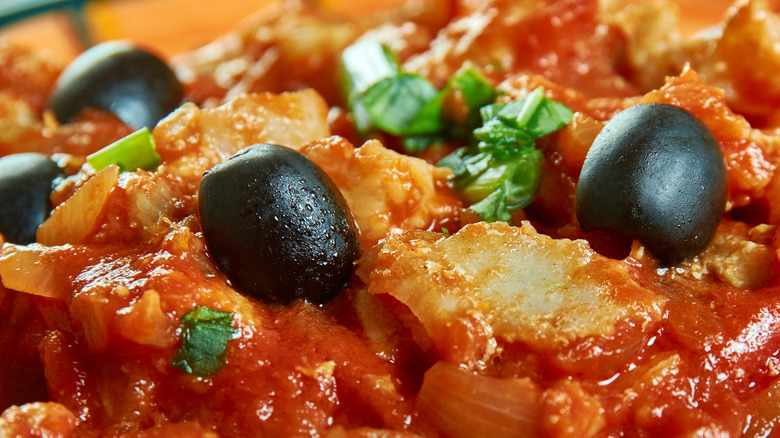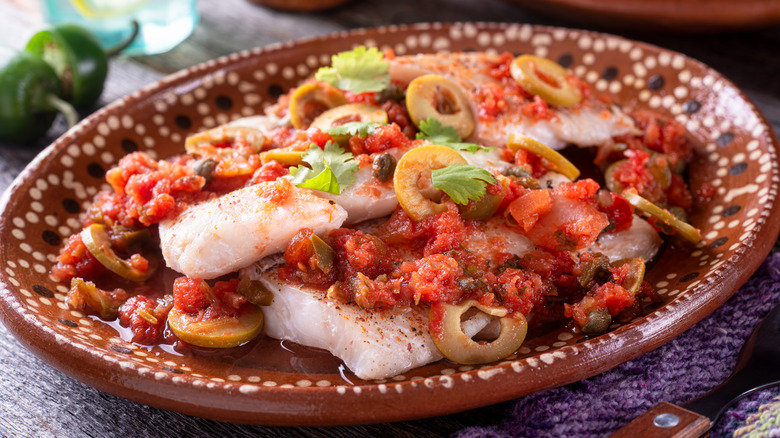The Ingredients That Give Veracruz-Style Sauce Its Distinctly Fresh Taste
Located along the eastern coast of Mexico, Veracruz is a multicultural and beautiful state with some of the most beloved culinary gifts in the republic, including vanilla, coffee, and jalapeños. Veracruz cuisine takes advantage of its climate, geography, and blended history, resulting in many iconic dishes. Veracruz-style sauce adorns one of the state's most famous dishes, with a fascinating cultural and historical background.
Known in Spanish as salsa Veracruzana, Veracruz-style sauce is a bright, aromatic sauce served over fish or chicken. The ingredients that give salsa Veracruzana its distinctly fresh taste are a combination of native Mexican tomatoes and jalapeños, with onions, capers, olives, and garlic brought over from the Old World.
Veracruz-style sauce uses fresh and pickled ingredients, supplying a diverse palate that blends the zesty and spicy flavors of Mexico with the earthy, umami, and aromatic flavors of the Spanish Mediterranean. The combination of flavors reflects a meeting of cultures that lies at the heart of Mexican identity.
History and cultural significance of Veracruz-style sauce
Veracruz-style sauce comes from the traditional Veracruzan dish, Huachinango a la Veracruzana, featuring heaping servings of the sauce served over whole snapper. The dish depicts how history and ecology shape local cuisine. Red snapper is native to the gulf coast and consequently a major source of protein in coastal people's diets throughout history. The gulf coast of Veracruz is also the first point of contact between indigenous Mexicans and the Spanish conquistadors in the early 16th century. Huachinango a la Veracruzana uses Veracruz's bountiful coastal ecology and the culinary exchanges between the Old and New World.
Indigenous Mexicans had experience cooking with tomatoes and jalapeños as native Mexican food crops; jalapeños get their name from residents of the city of Xalapa, the state capital of Veracruz. Capers, olives, onions, and garlic are Old World cultivars brought by Europeans to the New World. The mixture of ingredients reflects the mixture of these two cultures, a term Mexicans refer to as "mestizaje", which is the core of modern Mexican identity.
As a taste of Mexican history and complex cultural identity, Veracruz-style sauce has earned a special place in Veracruz's heart and diet. You'll see it on the menu at restaurants and at home throughout Veracruz's coastal towns and cities.
How it's made and enjoyed
While the traditional dish of Huachinango a la Veracruzana pairs Veracruz-style sauce with red snapper, it tastes delicious over any fish filet, shellfish, chicken, or even stuffed inside empanadas. There are also regional variations, including adding fresh herbs like oregano and raisins. Veracruz-style sauce is easy to make, using a mix of canned and fresh ingredients. The recipe starts by frying minced garlic in olive oil until fragrant before adding sliced white onion and either fresh, diced tomatoes or canned diced tomatoes.
Sautéing the tomatoes, onions, and garlic will create a caramelized and aromatic foundation for the briny capers, olives, and pickled jalapeños. Pickled jalapeños add spice and tang in equal measures, but you could also use fresh diced jalapeños without the seeds. The sauce is well-spiced but mild, so deseeding fresh jalapeños ensures you get the pepper's flavor without the heat. Raisins are a popular additive to Veracruz sauce because they contribute to the depth of texture and flavor, bestowing chewy and juicy pops of sweetness that complement spicy and umami flavors.


